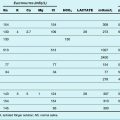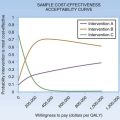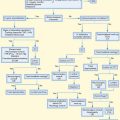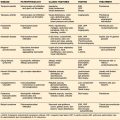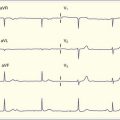197 Anxiety and Panic Disorders
• Anxiety disorders are the most common psychiatric illnesses diagnosed in adolescents and older adults, are increasingly being seen in urban emergency departments, and occur more frequently in women than in men.
• Potentially life-threatening medical disorders may feature somatic and cognitive signs and symptoms that often mimic anxiety on initial evaluation.
• Most anxiety disorders have significant familial aggregation, with the inheritability of panic disorder approaching a rate of 40%.
• Panic attack is a discrete episode of sudden, intense apprehension, fearfulness, or terror that is often associated with feelings of impending doom.
• Benzodiazepines are the recommended first-line agents for the pharmacologic management of anxiety.
Definition and Epidemiology
Anxiety is defined as an unpleasant emotional state consisting of psychologic and physiologic responses to the anticipation of real or imagined danger.1 Regardless of whether the observed disease prevalence is related to the escalating complexity and stress of traumatic events and modern life, evolving access to medical and behavioral health care, the inherent nature of the emergency department (ED), or an increased awareness of psychiatric disorders, anxiety is common in patients who seek emergency care.2,3
In the United States, anxiety disorders have a 12-month prevalence of 18% and a lifetime prevalence that approaches 25%. Anxiety-related conditions cost more than $42 billion in medical expenses and lost worker productivity in 1990 alone.4–6 Patients with anxiety disorders use outpatient and emergency care more often and generate higher medical costs than do patients without anxiety disorders.7
Anxiety disorders are increasingly being seen in urban EDs and, particularly panic disorder, occur more frequently in women than in men.3,8 These conditions are the most common psychiatric illnesses diagnosed in children, adolescents, and older adults.9,10 Anxiety disorders may significantly affect a patient’s quality of life and overall health. Anxiety is commonly associated with depression, other mood disorders, and substance abuse.
Pathophysiology
Anxiety disorders are caused by a combination of biologic factors and environmental influences.11 Despite increased basic science and clinical research, a specific explanatory mechanism or model to describe the exact causes of anxiety has yet to be identified.
The genetic epidemiology of anxiety disorders has been confirmed by numerous studies and metaanalysis. Most anxiety disorders have significant familial aggregation, and the inheritability of panic disorder approaches a rate of 40%.12
Several neurotransmitters play integral roles in the pathophysiology of stress and mood and anxiety disorders. Decreased γ-aminobutyric acid and serotonin receptor sensitivity are common in most anxiety disorders. Overactivity of the central norepinephrine system and elevated sensitivity to lactate and carbon dioxide are prominent findings in panic disorder. Cholecystokinin and increased excitatory neurotransmission by glutamate may contribute to the evolution of conditioned fear.13,14 Evolving research suggests that dopamine and corticotropin-releasing factor play a role in both mood and anxiety disorders.14,15
An environmental factor is integral to the development of anxiety. Stressful childhood experiences, such as abuse and divorce, contribute to generalized anxiety and panic disorders.11 Caffeine and other socially accepted stimulants (e.g., taurine, ginseng), as well as recreational substances (e.g., cocaine, methamphetamine, γ-hydroxybutyrate, jimson weed, salvia), often promote symptoms of anxiety.16,17 Finally, increasing exposure to violence, natural disasters, terrorism, and other traumatic events has caused greater numbers of people to suffer from acute stress reactions, anxiety, depression, and posttraumatic stress disorder.18,19
Clinical Presentation
Anxiety may be accompanied by many somatic and cognitive signs and symptoms, as listed in Box 197.1.9,10,20 The physical symptoms of acute anxiety are similar to those of excitation, such as chest pain, dry mouth, dyspnea, lightheadedness, and palpitations. Symptoms of subacute or chronic anxiety include fatigue, insomnia, and menstrual abnormalities. An anxious patient may have normal findings on physical examination or may exhibit tachycardia, tachypnea, and diaphoresis.
Children may not be able to articulate their fear or anxiety. As a result, an anxious pediatric patient may have seemingly disparate chief complaints, such as nonspecific abdominal pain and headache. During examination, anxious pediatric patients may have a temper tantrum or may appear more clingy or needy than expected.9
A panic attack may be the feature of most anxiety disorders.21 A panic attack is a discrete episode of intense fear or discomfort in the absence of real danger that meets specific symptomatic criteria. The intensity of a panic attack usually peaks within 10 minutes and resolves within 30 minutes. Panic attacks are often accompanied by at least 4 of 13 discreet somatic and cognitive symptoms.22
Differential Diagnosis, Diagnostic Criteria, and Testing
As evidenced by the broad range of associated signs and symptoms, anxiety disorders are part of an extensive differential diagnosis. Anxiety may represent a primary psychiatric condition or may be secondary to a medical illness. More than a dozen different anxiety disorders have similar physical symptoms and signs (Box 197.2).22
Box 197.2
Definitions of Anxiety Disorders
Panic attack is a discrete period characterized by the sudden onset of intense apprehension, fearfulness, or terror; it is often associated with feelings of impending doom.
Agoraphobia is anxiety about or avoidance of places or situations from which escape may be difficult (or embarrassing) or in which help may not be available in the event of a panic attack or panic-like symptoms.
Panic disorder without agoraphobia is characterized by recurrent, unexpected panic attacks about which persistent concern exists.
Panic disorder with agoraphobia is characterized by both recurrent, unexpected panic attacks and agoraphobia.
Agoraphobia without history of panic disorder is characterized by the presence of agoraphobia and panic-like symptoms without a history of unexpected panic attacks.
Specific phobia is characterized by clinically significant anxiety provoked by exposure to a specific fear, object, or situation; it often leads to avoidance behavior.
Social phobia is characterized by clinically significant anxiety produced by exposure to certain types of social or performance situations; it often leads to avoidance behavior.
Obsessive-compulsive disorder is characterized by obsessions (which cause marked anxiety or distress) or compulsions (which serve to neutralize anxiety).
Posttraumatic stress disorder is characterized by the recurrent mental experience of an extremely traumatic event accompanied by symptoms of increased arousal and avoidance of stimuli associated with the trauma.
Acute stress disorder is characterized by symptoms similar to those of posttraumatic stress disorder that occur immediately after an extremely traumatic event.
Generalized anxiety disorder is characterized by at least 6 months of persistent and excessive anxiety and worry.
Anxiety disorder due to a general medical condition is characterized by prominent symptoms of anxiety that are judged to be a direct physiologic consequence of a general medical condition.
Substance-induced anxiety disorder is characterized by prominent symptoms of anxiety that are judged to be a direct physiologic consequence of drug abuse, medication use, or toxin exposure.
Anxiety disorder not otherwise specified is included for coding disorders with prominent anxiety or phobic avoidance that do not meet the criteria for any of the specific anxiety disorders.
Data from American Psychiatric Association. Diagnostic and statistical manual of mental disorders. 4th ed, text rev. Washington, DC: American Psychiatric Association; 2000. pp. 429–30.
The first and most important step in evaluating an anxious patient is to search for potential medical causes of the patient’s symptoms. As noted in Table 197.1, many different medical conditions and medications mimic, manifest, produce, or exacerbate anxiety.17,23–25 Thorough evaluation of all of the patient’s recent and past medical problems, current medications and supplements (including those available over the counter), family history, and social history (especially substance use and social stressors) may preclude an exhaustive and unnecessary medical work-up.26 The onset of a new behavioral symptom at a late age or the report of any feature that is not typically associated with anxiety increases the likelihood of a medical cause.
| SYSTEM OR CAUSE | CONDITION |
|---|---|
| Cardiac | Angina, arrhythmias, hypertensive urgency or emergency, mitral valve prolapse, myocardial ischemia, Takotsubo syndrome |
| Endocrine | Addison disease, carcinoid syndrome, Cushing syndrome, diabetes, parathyroid disease, pheochromocytoma, postpartum depression, thyroid disease |
| Exogenous | Caffeine or stimulant use, dietary supplement use, herbal remedies, acute intoxication (alcohol, amyl nitrate, cocaine, γ-hydroxybutyrate, khat, lysergic acid diethylamide [LSD], methamphetamine, salvia, yohimbine), monosodium glutamate, tyramine-containing foods in combination with monoamine oxidase inhibitors, withdrawal (alcohol, benzodiazepine, heroin, sedative) |
| Gastrointestinal | Dyspepsia, gastroesophageal reflux disease, irritable bowel syndrome, liver failure |
| Immunologic | Allergic reaction and mastocytosis |
| Infectious | Acute or evolving infection, human immunodeficiency virus infection, neurosyphilis |
| Medication | Amphetamine/dextroamphetamine (Adderall), albuterol, anticholinergics, digitalis, dystonic reaction, agents for erectile dysfunction, estrogen, histamine 1 and 2 blockers, selective serotonin reuptake inhibitors, serotonin syndrome, theophylline |
| Metabolic | Electrolyte abnormalities (calcium, glucose, magnesium, phosphorus, potassium, sodium, urea), nutritional deficiencies (vitamin deficiency such as B12 and folate), porphyrias, Wilson disease |
| Neurologic | Brain tumors, cerebrovascular accidents (including transient ischemia attack), degenerative disorders (Huntington chorea, multiple sclerosis, myasthenia gravis), delirium, dementia (Alzheimer type), encephalitis, meningitis, seizure disorder (nonconvulsive and temporal lobe) |
| Psychiatric | Conversion disorder, depression, insomnia or sleep disorders, mania, psychosis, schizophrenia, stress disorder or stressors (e.g., abuse, finances, marital or relationship, trauma) |
| Pulmonary | Asthma, chronic obstructive pulmonary disease, pulmonary embolism, upper respiratory infection |
An appropriate physical examination helps identify or eliminate potential causes of anxiety. Abnormal vital signs and characteristic toxidromes often signal the presence of a medical illness or drug-associated condition. A focused neurologic examination, including mental status, is critical to the diagnosis of intracranial disease.27
Myocardial infarction, angina pectoris, and dysrhythmias may have clinical findings similar to those of a panic attack. Several studies have indicated that up to 30% of patients with chest pain who are evaluated in the ED meet the diagnostic criteria for panic disorder. Alternatively, more than 40% of patients with panic disorder had documented coronary artery disease in a related study.28
Nearly 25% of medical conditions that cause symptoms of anxiety are endocrine disorders such as hypoglycemia, hyperthyroidism, and hypoparathyroidism.29 Approximately 30% to 50% of female hyperthyroid patients suffer from panic and generalized anxiety disorders.30
Transient ischemic attacks, temporal lobe seizures, and brain tumors may promote anxiety. Up to 50% of patients with intracranial tumors, such as pituitary adenomas and metastatic disease, may have psychiatric manifestations.31
Treatment
Benzodiazepines are the recommended first-line agents for pharmacologic management and may be given orally to patients in the ED for minimal to moderate symptoms. In those with severe symptoms, intravenous lorazepam, diazepam, and midazolam should be administered. Lorazepam may be given in 0.5-mg doses, whereas diazepam and midazolam may be given in 1- to 2-mg increments. For milder, less urgent symptoms and limited outpatient use, the recommended dose of clonazepam and alprazolam is 0.25 to 0.50 mg.21,32 Buspirone, monoamine oxidase inhibitors, selective serotonin reuptake inhibitors, and recently, cognitive behavioral therapy are used by psychiatrists for the outpatient treatment of anxiety disorders.33–36
Disposition
Most anxious patients may be discharged home after appropriate ED evaluation and stabilization. Immediate psychiatric consultation is recommended for anxious patients who report suicidal or homicidal ideation, who are severely depressed or unable to care for themselves, or who may not have reliable follow-up. Coordination with a behavioral health resource or case management–based intervention may also improve follow-up care.37 Anxious patients discharged from the ED should be instructed to seek care from their primary physician or mental health provider as soon as possible.
1 Dorland’s illustrated medical dictionary. 30th ed. Philadelphia: Saunders; 2003.
2 Larkin GL, Claasen CA, Emond JA, et al. Trends in U.S. emergency department visits for mental health conditions, 1992 to 2001. Psychiatr Serv. 2005;56:671–677.
3 Smith RP. Trends in U.S. emergency department visits for anxiety-related mental health conditions, 1992-2001. J Clin Psychiatry. 2008;69:286–294.
4 Kessler RC, Chiu WT, Demler O, et al. Prevalence, severity, and comorbidity of 12-month DSM-IV disorders in the National Comorbidity Survey replication. Arch Gen Psychiatry. 2005;62:617–627.
5 Greenberg PE, Sisitsky T, Kessler RC, et al. The economic burden of anxiety disorders in the 1990s. J Clin Psychiatry. 1999;60:427–435.
6 Kessler RC, McGonagle KA, Zhao S, et al. Lifetime and 12-month prevalence of DSM III-R psychiatric disorders in the United States: results from the National Comorbidity Survey. Arch Gen Psychiatry. 1994;51:8–19.
7 Olfson M, Gameroff MJ. Generalized anxiety disorder, somatic pain, and health care costs. Gen Hosp Psychiatry. 2007;29:310–316.
8 Weissman MM, Bland RC, Canino GJ, et al. The cross-national epidemiology of panic disorder. Arch Gen Psychiatry. 1997;54:305–309.
9 Varley CK, Smith CJ. Anxiety disorders in the child and teen. Pediatr Clin North Am. 2003;50:1107–1138.
10 Lauderdale SA, Sheikh JI. Anxiety disorders in older adults. Clin Geriatr Med. 2003;19:721–741.
11 Hettema JM, Prescott CA, Myers JM, et al. The structure of genetic and environmental risk factors for anxiety disorders in men and women. Arch Gen Psychiatry. 2005;62:182–189.
12 Hettema JM, Neale MC, Kendler KS. A review and meta-analysis of the genetic epidemiology of anxiety disorders. Am J Psychiatry. 2001;158:1568–1578.
13 Krystal JH, D’Souza DC, Sanacora G, et al. Advances in the pathophysiology and treatment of psychiatric disorders: implications for internal medicine. Med Clin North Am. 2001;85:559–577.
14 Martin EI, Ressler KJ, Binder E, et al. The neurobiology of anxiety disorders: brain, imaging, genetics, and psychoneuroendocrinology. Psychiatr Clin North Am. 2009;32:549–575.
15 Jetty PV, Charney DS, Goddard AW. Generalized anxiety disorder: neurobiology of generalized anxiety disorder. Psychiatr Clin North Am. 2001;24:75–97.
16 Zvosec DL, Smith SW. Agitation is common in gamma-hydroxybutyrate toxicity. Am J Emerg Med. 2005;23:316–320.
17 Meehan TJ, Bryant SM, Aks SE. Drugs of abuse: the highs and lows altered mental states in the emergency department. Emerg Med Clin North Am. 2010;28:663–682.
18 Ritchie EC, Owens M. Military issues. Psychiatr Clin North Am. 2004;27:459–471.
19 Van Den Berg B, Grievink L, Stellato RK, et al. Symptoms and related functioning in a traumatized community. Arch Intern Med. 2005;165:2402–2407.
20 Milner KK, Florence T, Glick RL. Emergency psychiatry: mood and anxiety syndromes in emergency psychiatry. Psychiatr Clin North Am. 1999;22:755–777.
21 Merritt TC. Psychiatric emergencies: recognition and acute management of patients with panic attacks in the emergency department. Emerg Med Clin North Am. 2000;18:289–300.
22 American Psychiatric Association. Diagnostic and statistical manual of mental disorders. text rev. 4th ed. Washington, DC: American Psychiatric Association; 2000.
23 Lagomasino I, Daly R, Stoudemire A. Medical assessment of patients presenting with psychiatric symptoms in the emergency setting. Psychiatr Clin North Am. 1999;22:819–850.
24 Geeraerts B, Vandenberghe J, van Oudenhove L, et al. Influence of experimentally induced anxiety on gastric sensorimotor function in humans. Gastroenterology. 2005;129:1437–1444.
25 Dvir Y. Serotonin syndrome: a complex but easily avoidable condition. Gen Hosp Psychiatry. 2008;30:284–287.
26 Sood TR, McStay CM. Evaluation of the psychiatric patient. Emerg Med Clin North Am. 2009;27:669–683.
27 Talbot-Stern JK, Green T, Royle TJ. Psychiatric emergencies: psychiatric manifestations of systemic illness. Emerg Med Clin North Am. 2000;18:199–209.
28 Fleet RP, Dupuis G, Marchand A, et al. Panic disorder in emergency department chest pain patients: prevalence, comorbidity, suicidal ideation, and physician recognition. Am J Med. 1996;101:371–380.
29 Bazakis AM, Kunzler C. Altered mental status due to metabolic or endocrine disorders. Emerg Med Clin North Am. 2005;23:901–908.
30 Bunevicius R, Velickiene D, Prange AJ. Mood and anxiety disorders in women with treated hyperthyroidism and ophthalmopathy caused by Graves’ disease. Gen Hosp Psychiatry. 2005;27:133–139.
31 Galasko D, Kwo-On-Yuen PF, Thal L. Intracranial mass lesions associated with late-onset psychosis and depression. Psychiatr Clin North Am. 1988;11:151–166.
32 Currier GW, Allen MH, Bunney EB, et al. Standard therapies for acute agitation. J Emerg Med. 2004;27(Suppl):S9–S12.
33 Kapczinski F, Lima MS, Souza JS, et al. Antidepressants for generalized anxiety disorder. Cochrane Database Syst Rev. 2, 2003. CD003592
34 Otto MW, Tuby KS, Gould RA, et al. An effect-size analysis of the relative efficacy and tolerability of serotonin selective reuptake inhibitors for panic disorder. Am J Psychiatry. 2001;158:1989–1992.
35 Wittchen H, Gloster AT. Developments in the treatment and diagnosis of anxiety disorders. Psychiatr Clin North Am. 2009;32:xii–xix.
36 Hicks D, Cummings T, Jr., Epstein SA. An approach to the patient with anxiety. Med Clin North Am. 2010;94:1127–1139.
37 Kolbasovsky A. Reducing the number of emergency department visits and costs associated with anxiety: a randomized controlled study. Am J Manag Care. 2007;13:95–102.

